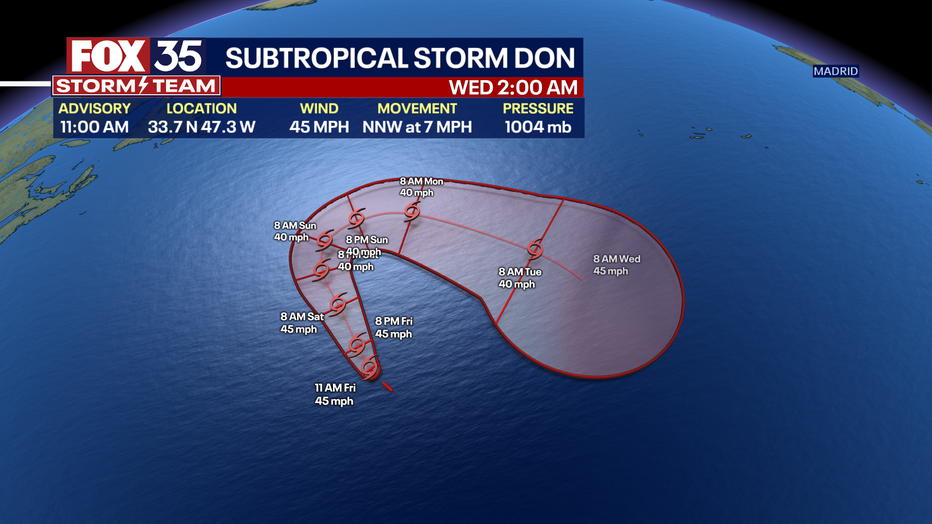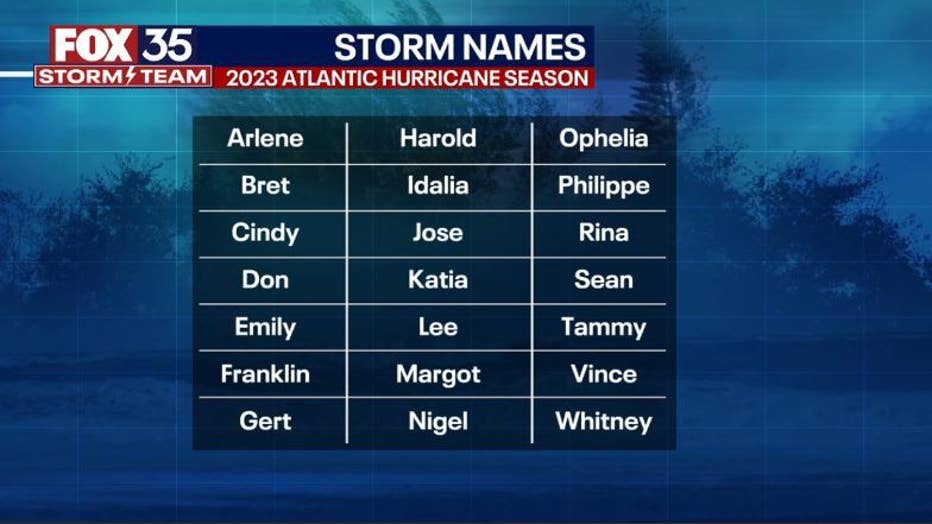Subtropical Storm Don forms over Atlantic, expected to weaken this weekend: NHC

Tracking the Tropics: July 14, 2023
The FOX 35 Storm Team and the National Hurricane Center are monitoring Subtropical Storm Don, which formed early Thursday morning in the Central Atlantic.
Subtropical Storm Don formed over the Central Atlantic early Friday morning, according to the National Hurricane Center.
The system is producing maximum sustained winds of 45 mph as of 11 a.m. and is moving north-northwest at 7 mph. Don is expected to continue this motion through Friday night.
Don is forecast to turn toward the north Saturday and toward the east by Sunday or Monday, the NHC said.
The storm's winds have already decreased this morning from 50 mph to 45 mph, and additional weakening is expected over the next few days. Don could become a post-tropical cyclone or remnant low at any time, the NHC said.
There are no coastal watches or warnings in effect at this time.
Where is Subtropical Storm Don?
The system is located over 1,170 miles west of the Azores.

Will Subtropical Storm Don affect the US or Florida?
The storm remains far away in the distant Atlantic at this time, and it's not a direct threat to Florida or any land, for that matter, according to the FOX 35 Storm Team.
The system could, though, send an increase in long-period ocean swells by the middle of next week.
The FOX 35 Storm Team will continue to monitor the situation.
MORE HURRICANE NEWS:
- 2023 Atlantic hurricane season could be busier with more storms than initially thought
- What to expect in the tropics as Atlantic hurricane season enters July
- Atlantic hurricane season sees above-average start with 3 tropical storms in June
What's the difference between a subtropical storm and a tropical storm?
Both tropical and subtropical storms have maximum sustained surface wind speeds of 39 mph, but there are a few more factors that determine which is which.
While they both form low-pressure systems over the ocean, a subtropical storm has the characteristics of both a tropical storm and a non-tropical weather system, according to FOX 35 Storm Team Chief Meteorologist Jayme King.
A major difference between the two is temperature: Both types of storms develop over warm tropical or subtropical waters, but a subtropical storm has cooler upper-level temperatures in its core.
Another difference is the size of their wind field.
A subtropical storm has a defined center, but the maximum sustained winds and thunderstorm activity usually occur relatively far away from it. The wind field, as it's known, can be rather expansive, sometimes hundreds of miles.
A tropical storm’s maximum sustained winds are wrapped around the center and will become more tightly wound as the storm intensifies, eventually forming the wall around the distinctive eye seen on satellite imagery.
2023 Atlantic hurricane season storm names
The 2023 Atlantic hurricane season has already had an "above average" with three named storms in June, according to the National Hurricane Center.
Typically, June sees one named tropical storm, according to the National Hurricane Center, utilizing the last 30 years of weather data and climatology. However, June 2023 saw three named storms: Tropical Storm Arlene, Tropical Storm Bret, and Tropical Storm Cindy.

Don is the fourth named storm of the season. Here's a look at the other names for storms this year:
- Arlene (Pronunciation: ar-LEEN)
- Bret (Pronunciation: bret)
- Cindy (Pronunciation: SIN-dee)
- Don (Pronunciation: dahn)
- Emily (Pronunciation: EH-mih-lee)
- Franklin (Pronunciation: FRANK-lin)
- Gert (Pronunciation: gert)
- Harold (Pronunciation: HAIR-uld)
- Idalia (Pronunciation: ee-DAL-ya)
- Jose (Pronunciation: ho-ZAY)
- Katia (Pronunciation: KAH-tyah)
- Lee (Pronunciation: lee)
- Margot (Pronunciation: MAR-go)
- Nigel (Pronunciation: NY-juhl)
- Ophelia (Pronunciation: o-FEEL-ya)
- Philippe (Pronunciation: fee-LEEP)
- Rina (Pronunciation: REE-nuh)
- Sean (Pronunciation: shawn)
- Tammy (Pronunciation: TAM-ee)
- Vince (Pronunciation: vinss)
- Whitney (Pronunciation: WHIT-nee)

